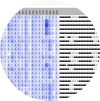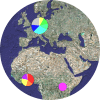Welcome to the MIRU-VNTRplus web application!
 |
Molecular typing of bacteria from the Mycobacterium tuberculosis complex (MTBC) is essential for epidemiological purposes such as investigating the spreading of specific genotypes. Recently, mycobacterial interspersed repetitive units (MIRU) typing has become an important method, as it allows high-throughput, discriminatory and reproducible analysis of clinical isolates. Because of its portable data format, MIRU typing has the potential to be a versatile tool for individual strain identification based on large reference databases. However, specialized bioinformatic web tools to analyze MIRU data and public reference databases are not available. |
|
To meet this need, a collection of |  |
 |
Via the freely accessible MIRU-VNTRplus service users can compare their strain(s) with the reference strains for the assignment of MTBC species, lineages, and genotypes. For easier scientific communication a universal expanding nomenclature (MV15-9) to name different MIRU genotypes is maintained at the server. Comparisons can be based on MIRU-, spoligo-, RD-, SNP-, susceptibility-typing data, or by a combination of different data types. Several distance coefficients are available, including Jaccard's and categorical. Based upon the respective distance matrix, a dendrogram can be calculated using UPGMA or neighbor-joining clustering algorithms. The resulting trees may be exported in various data formats. MIRU-VNTRplus provides also functions for the user to analyze own strains without interrogating the reference database. Extensive documentation (manual and tutorials) of the service is available to make best use of all features. |